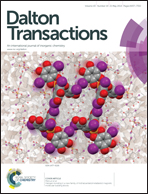Tetrahydropentalenyl-phosphazene constrained geometry complexes of rare-earth metal alkyls†
Abstract
Reactions of Cp™HPPh2 (1, diphenyl(4,4,6,6-tetramethyl-1,4,5,6-tetrahydropentalen-2-yl)phosphane) with the organic azides AdN3 and DipN3 (Ad = 1-adamantyl; Dip = 2,6-di-iso-propylphenyl) led to the formation of two novel CpPN ligands: P-amino-cyclopentadienylidene-phosphorane (Cp™PPh2NHAd; LAdH) and P-cyclopentadienyl-iminophosphorane (Cp™HPPh2NDip; LDipH). Both were characterized by NMR spectroscopy and X-ray structure analysis. For both compounds only one isomer was observed. Neither possesses any detectable prototropic or elementotropic isomers. Reactions of these ligands with [Lu(CH2SiMe3)3(thf)2] or with rare-earth metal halides and three equivalents of LiCH2SiMe3 produced the desired bis(alkyl) Cp™PN complexes: [{Cp™PN}M(CH2SiMe3)2] (M = Sc (1Ad, 1Dip), Lu (2Ad, 2Dip), Y (3Ad, 3Dip), Sm (4Ad), Nd (5Ad), Pr (6Ad), Yb (7Ad)). These complexes were characterized by extensive NMR studies for the diamagnetic and the paramagnetic complexes with full signal assignment. An almost mirror inverted order of the paramagnetic shifts has been observed for ytterbium complex 7Ad compared to 4Ad, 5Ad and 6Ad. For the assignment of the NMR signals [{η1 : η5-C5Me4PMe2NAd}Yb(CH2SiMe3)2] 7 was synthesized, characterized and the 1H NMR signals were compared to 7Ad and to other paramagnetic lanthanide complexes with the same ligand. 1Ad, 2Ad, 2Dip, 3Ad and 3Dip were characterized by X-ray structure analysis revealing a sterically congested constrained geometry structure.


 Please wait while we load your content...
Please wait while we load your content...